Affiliate disclosure: This post may contain affiliate links. Please see our Privacy Policy.
Every time nuclear proliferation comes up in the news, I start thinking “I need more seeds.” Really, in a nuclear war, seeds aren’t really going to help anyone. Short of an actual nuclear apocalypse, there are plenty of disasters, natural or man-made, that could be resolved by having a bit of seed-based resilience on hand.
We grow much of our own food, but I have this nagging fear that someday we’ll really need that knowledge and ability, and I won’t have the seeds at hand.
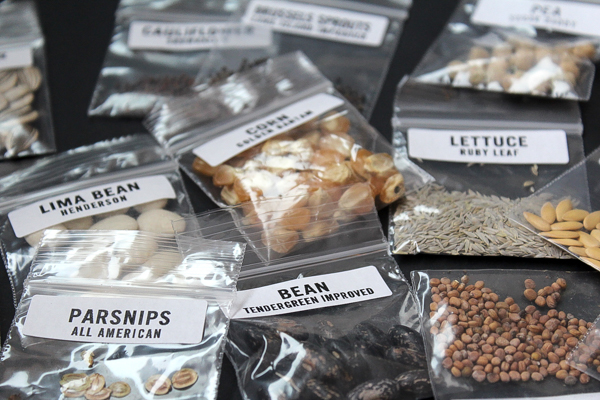
Table of Contents
- Seed Banks as a Tool For Beginning Gardeners
- How to Choose a Survival Seed Bank
- Appropriate to your Area
- Number of Varieties Included
- Practical v. Impractical Crops
- Packaging
- Germination Rate v. Plant Vigor
- Organic or Conventional Seed
- Heirloom or Hybrid
- Vegetables Only or Herbs/Perennials
- Other Resources Included
- Cost
- Storage Life
- Trust
- Comparing Survival Seed Banks
- Open Seed Vault Survival Seed Garden
- Survival Essentials Seed Bank
- Texas Ready Seed Bank
- Other Survival Seed Kits
A while back a big survivalist blog wanted me to write a post about a “survival garden backpack.” The idea was that in a serious crisis, someone could grab this backpack, and go up into the mountains and immediately begin growing their own food.
I laughed.
There’s no way someone with no knowledge or experience could take the content of a backpack to virgin land in the mountains and expect to survive on agricultural crops they grew. They could make it on wild game and foraged food perhaps if they really knew their stuff, but the idea was that they didn’t know anything. The whole premise was just to create a backpack that functioned as a security blanket for those with no knowledge of survival.
It’s not that easy.
There’s no “bug out bag” that’s going to solve your problem.
While a seed bank isn’t going to be a magic bullet to help you survive, it is a very useful tool. A seed bank ensures that you have a large variety of seed on hand, with a bit of everything to get you growing when you need to. Even if you do know how to grow your own food, likely you don’t have all the seeds on hand to supply yourself if you really needed to.
If you’re just learning to provide for yourself, a seed bank is a great place to start.
(If you’re being realistic, beyond a basic seed kit, you’ll also need some type of freeze-dried survival food kit to provide calories until your crops come in, and in the event of a crop failure. I’ve similarly reviewed literally dozens of options, and written up a separate article on the best and worst survival food kits.)
Seed Banks as a Tool For Beginning Gardeners
When I talk about survival seed banks, I’m talking about a tool for those that already know how to, or are learning how to grow much of their own food.
That said, a survival seed bank can actually be a great tool for learning how to grow your own food. If you’ve never grown anything, seed catalogs can be pretty intimidating. Survival seed banks offer a turn-key solution to get you started because their premise is that they have everything included.
There’s an old preparedness adage for food storage that says, “Eat what you store and store what you eat.” The same goes for a seed bank. If you’re hoping to live off of your own produce, or at least supplement your food supply in hard times, you should be practicing growing from your seed bank.
How to Choose a Survival Seed Bank
There are a lot of options out there in survival seed banks. I’m going to discuss some of the more common commercially prepared banks, along with the pros and cons of each. First, let’s start with some evaluation criteria:
Appropriate to your Area
This is my number 1 selection criteria. It’s hard to include varieties that are appropriate for every growing zone. If you live in an extreme zone, either cold or hot, it may be hard to find a seed bank that meets your needs.
Most try to be a one size fits all that works for most regions, but make sure that you’re conscious of your growing conditions.
In Vermont, with a 100 day long growing season, long season varieties with 120+ days to maturity won’t do us any good.
Number of Varieties Included
So why do you need 5 different varieties of any crop? Varieties were developed for a reason, and they have key differences.
Sauce tomatoes are very different from canning tomatoes, and the best tomatoes for canning are not the best tomatoes for slicing. Beyond that, one variety may do better in your soil or with the pests in your area.
Having more than one variety of any given crop means you’ve got a backup plan.
Practical v. Impractical Crops
My friend Scott at Backwoods Resistance joked about those survival seed kits that include a packet of wheat seeds. As if a packet, a single packet of ~50 seeds, was going to actually grow you enough wheat to make a single loaf of bread. Growing your own wheat on that small a scale is just not practical, and if a survival seed bank included ~50 wheat seeds you should know to run from those idiots.
My pet peeve is those that contain 600+ watermelon seeds.
Do you have any idea how much land you’d need to grow 600 watermelon plants, even if you planted 100 plants a year for 6 years? It’s preposterous. It’s also enough watermelon to supply the state of Vermont, but not many calories.
Packaging
Is the seed bank packed to be opened and closed, used and stored, tested and evaluated? Or is it hermetically sealed and designed based on blind trust? Are you supposed to keep it closed up tight, assuming there are viable seeds in there, but only open it in a dire emergency?
Seeds are meant to be grown and propagated, not sealed and stored. Any seed bank should be packaged to allow you to use it, not hoard it.
Germination Rate v. Plant Vigor
Just about every seed bank will advertise high germination rates. Even if you assume they’re telling you the truth, germination rates do not tell the whole story.
The book Gardening When It Counts, which I highly recommend, was written by a seed farmer. The author goes to great length to explain that plant seed will germinate, or sprout, for much longer than it will produce a viable crop.
As a seed is stored, the nutrients to feed the developing plant degrade, and though seeds may germinate, they might not thrive. This is one reason why you should use your seed bank, rather than hoard it. The seed does not get better with age, and you’re better off planting those seed bank seeds now and saving seed from your plants to replenish your bank each year.
Organic or Conventional Seed
For my own day-to-day growing, I use organic practices. Organic takes experience and it’s not the best option for everyone. You should know how to grow organically, because commercial fertilizers and pesticides may not be easily available at the corner store in an emergency situation.
That said, especially in an emergency, I’d use any tool I had at hand to bring a crop to bear.
Some seeds may come treated with inoculants or fungus inhibitors to improve germination rates and vigor. If the manufacturer of the bank has thought ahead to include treated seed, I’d tip my hat to them and thank them. They didn’t just throw seed into the packet, they thought about what you might actually need.
Heirloom or Hybrid
Hybrid seed is specially bred and is the first generation offspring of a desirable cross. Saving seeds from hybrids will not give you the same results as saving seeds from heirlooms.
Heirlooms are open-pollinated and require no special breeding to save seeds. Any responsible seed bank will only include heirlooms.
This is not to say there’s anything wrong with hybrids. They actually produce better in many circumstances.
The problem is, hybrid seed is just not really set up for home seed saving, so it’s a one-time use proposition.
Vegetables Only or Herbs/Perennials
Some seed banks include just annual vegetables, while others have herb and perennial seed. Think about what you’ll actually use.
Growing herbs is great if you know how to cook with them. Similarly, medicinal herbs won’t do you much good if you don’t know how to use them.
Other Resources Included
Some seed banks are just seeds, and others include gardening books, fertilizers or other additional items to get you growing.
Cost
I can’t pretend cost is not a huge issue. For a basic 1 or 2 person seed bank, costs range from $40 to $200. That’s a huge range, and it should be a consideration in any buying decision.
The most expensive is not necessarily the best, but to be frank, I’m pretty skeptical of anything that’s $40 and says it can grow enough food to feed me for a year. Be sure to evaluate the actual contents along with the cost.
Storage Life
Regardless of what any given company tells you, seed shelf life is about the same across manufacturers.
Certain seeds, like parsnips, just don’t keep. They are only viable for 1 year, and after that, the germination rate drops off to below 10% no matter how you store them. Other seeds, like corn, tend to have a much longer shelf life, and advertising a 5-year shelf life is not unreasonable.
Those that tell you the seed bank will last 25 years are flat-out lying. End of story.
To properly store seeds frozen, they need to be thoroughly dehydrated, well below the moisture levels of most seeds. If you’d like to read a thorough discussion of how to do this, I’d recommend the book The Resilient Gardener. The author is a plant breeder and prepares seeds for long-term storage by freezing, but it’s not a simple process.
Just throwing the whole sealed seed bank in the freezer may slightly extend the life of some varieties, but it won’t help short shelf life varieties like parsnips, and it won’t get you anywhere near 25 years of viability.
Trust
When you’re buying a seed bank, you’re outsourcing the seed selection process. You’re trusting someone else to choose varieties and to include good seed that will help you provide for your family.
Research the company and its reputation.
Where are they based? How are they reviewed? How do they present themselves?
Do they provide false promises, and try to make you believe that their seed bank is all you need to survive any zombie apocalypse?
Comparing Survival Seed Banks
Now that we’ve established selection criteria, let’s compare some of the seed banks available on the market today. Three companies were kind enough to send me a sample of their seed banks for this review.
The kits under review are The Survival Seed Garden from Open Seed Vault, the Large Survival Seed Kit from Survival Essentials Seed Bank and the Piggy Bank 2 Person Northern Seed Bank from Texas Ready.
All three kits shipped from within the US.
I’ve also taken a look at a number of other seed kits available online through a variety of retailers.
Open Seed Vault Survival Seed Garden
Open seed vault makes two different small seed banks: The Survival Seed Garden and a Culinary & Medicinal Herb Garden. The survival seed garden is currently a best seller on Amazon, and it’s the most economical. The survival seed garden has 32 varieties, and the herb garden has 12 varieties.
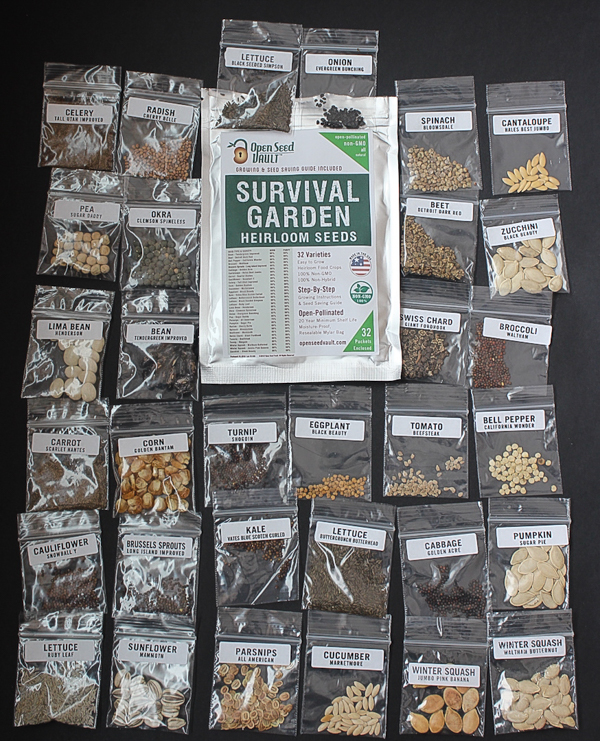
What I Like About The Kit:
It’s economical. Assuming that the seeds germinate and produce viable plants, which I’ll be testing later this summer, there’s no other way I know of to get 32 seed packets for so little.
Seed packets these days sell for $4 to $6 each, meaning that you just bought over $150 worth of seed. Sweet deal!
The varieties included are heirloom varieties, which took extra effort to seek out. Heirloom types of certain seeds, like Brussel sprouts and cauliflower, can be hard to come by. All the varieties included mature in under 100 days, making this seed kit reasonable for northern and southern gardeners.
The packet contains a growing guide, with remarkably good instructions on how to grow each variety. It also gives you step-by-step instructions on seed saving.
The kit comes packed in sealed mylar pouches that are resealable with a zipper, and each individual seed packet is resealable.
What I Don’t Like:
The seed number of seeds for each variety seems to be determined by the size of the Ziploc seed bags rather than how many you might actually need. For example, there are perhaps 500 celery seeds, but only about 25 corn seeds.
Corn is a much more important staple in your diet than celery, but more importantly, it’s difficult to get good pollination when you only plant a small patch of corn. Since corn pollen is heavy and needs to fall on the corn silk for pollination, you need at least a 10×10 foot square of corn to see good production on any given plant.
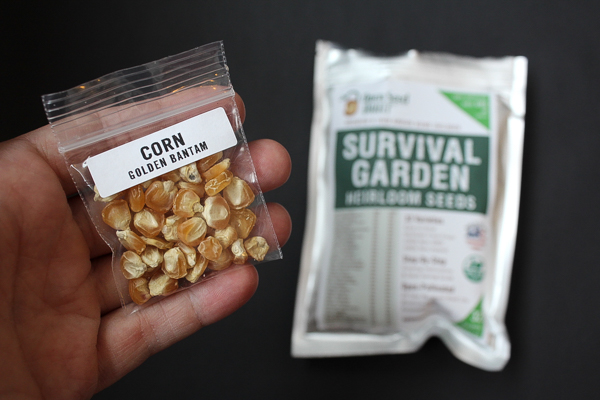
There was a limited quantity of other large-seeded crops, including beans, peas, and squash. Beans, peas, and squash are higher calorie crops, beans and peas are both high in protein and squash is a storage crop. Ideally, there would be many more of these seeds, and fewer greens and celery.
There was only one variety of each vegetable. The varieties chosen are, for the most part, fresh eating varieties.
There are no dry beans, only fresh green beans. The tomato variety included is a fresh slicing tomato, rather than a canning/sauce tomato.
In the herb kit, though it says “culinary and medicinal,” the varieties included are what we think of as culinary herbs. Sure, thyme does have some medicinal properties, but it’s now what you’d consider survival medicine.
The pack includes 12 varieties, along with 12 compressed peat pellets for seed starting. The inclusion of the peat pellets is a bit confusing to me because it’s enough to start one plant of each variety. I can imagine new gardeners being confused and pouring all the seeds from any given packet into one and killing them all.
Besides that, peat pellets are actually pretty difficult to use for seed starting, because it’s hard to regulate moisture. I wish they would have included twice as many seed varieties and some actual medicinals, and skipped the peat pellets altogether.
Who Is The Kit For?
If you’re a beginning gardener that’s using a survival seed kit to learn how to grow your own food, there’s no more economical way to do it. Seeds are expensive, and if you want to learn to grow a variety of crops you’re looking at a sizable investment. This is a practical way to buy in a whole garden’s worth of seed for a small investment.
(Update: I tested the germination rates in this kit, and I was really impressed, and most varieties exceeded 90%.)
Survival Essentials Seed Bank
Survival Essentials offers two seed kits. The basic survival seed bank kit contains 100 varieties and offers free extra microgreen seeds to keep you gardening indoors year-round.
The larger survival seed kit contains 135 varieties, plus a bonus of 9 rare tomato varieties. Both kits are extremely well-reviewed on Amazon, with hundreds of 5-star ratings from verified purchasers.
I received the larger 135 variety kit for review.
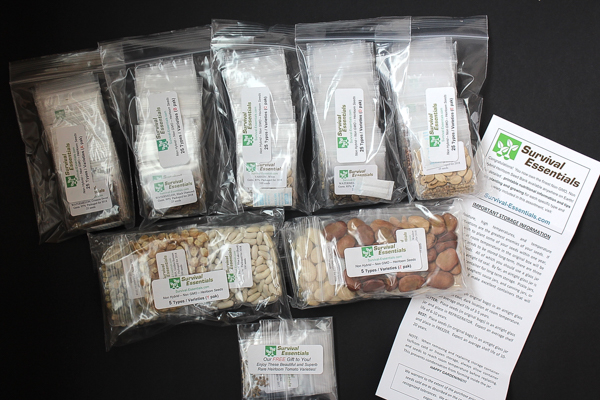
One Amazon review particularly stuck with me:
“I bought this for my brother as a Christmas present in 2014. He was fresh out of the military, struggling with depression, and trying to find his way in the world. He needed an outlet. Something to focus on. I took a chance on something different. He absolutely loved it.
With all of that being said, I was so scared that these seeds were going to let me, but more importantly, him down. They have not.
He is now in his second season planting seeds from the kit I gave him and is having tremendous success. There was nothing he couldn’t get to produce, even in that tough Georgia red clay, and with that oppressive summer sun and humidity. He found the website extremely helpful, giving him ideas of what and when to plant certain things. This year he is taking it to a whole new level, with raised flower beds, compost heaps, and mini greenhouses for year-round planting.
I can happily say that this is a great product for the beginner looking to unplug and get outside, or the veteran green thumb looking for quality seeds.”
What I Like About The Kit:
It contains A LOT of seeds. Buying this quantity of seeds, with this much variety, would have cost me literally hundreds of dollars.
The packaging is well thought out, with each variety in its own bag, and then they’re packed into larger bags in groups of 25 along with a water-absorbing silica gel packet. That extra attention to detail to keep the seeds dry shows that this company is really thinking this through and wants you to succeed.
The large-seeded varieties, like corn, beans, and peas are packed separately, in groups of 5 varieties to a large bag. That means there are plenty of high-calorie, large-seeded varieties that would actually put substantial calories on the table for your family.
The “bonus” 9 varieties of tomato seeds are actually exactly as promised, rare heirlooms that are hard to come by. I’m pretty excited about these. Though tomatoes may not be super calorie-dense, exciting varieties go a long way in improving my morale and they don’t take up much space in the garden.
The kit includes some herbs, such as thyme and basil, as well as some legitimate medicinals like yarrow.
Though there are a lot of seeds, there are no silly crops, like wheat. The kit does include amaranth, which is a grain that can be grown, harvested and processed at a home scale. That’s a really thoughtful addition.
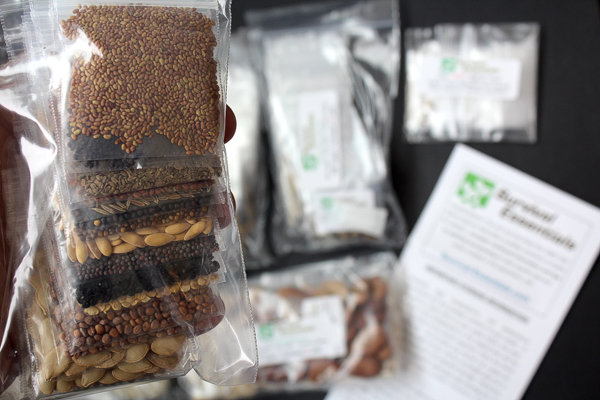
What I Don’t Like:
Honestly, there’s not much to not like. Minor points of criticism…there was only one variety of corn. In an ideal kit, I’d include 2-3 to make sure a crop came in.
I’d also be sure to include a flint corn variety, rather than just a sweet corn variety. Most people don’t know what to do with flint corn though, and wouldn’t have the equipment to process it, so that’s a minor point.
The instructions in the kit say that the seeds will keep 3 to 5 years on a pantry shelf, or 6 to 10 years stored in an airtight jar in the refrigerator. For optimal storage, they suggest keeping them in an airtight jar in the freezer and promise a 10 to 20-year shelf life in those conditions.
I think those shelf lives are a bit optimistic, and downright wrong for some short-lived seed varieties. Nonetheless, their storage instructions are detailed and the addition of silica packets shows they are doing everything they can to extend the shelf life.
Who Is The Kit For?
Anyone. If you really want to take a deep dive into gardening, this is a very economical way to buy your seeds.
As a survival seed kit, I’m happy with the selection of varieties. The quantities of each show that the maker really thought out what you’d need to have on hand, and in what ratio.
I’d recommend this as a starter garden kit or a survival seed bank kit.
Texas Ready Seed Bank
The Texas Ready Seed Bank is made by a Texas-based company. This is the only kit that allows you to select your growing region. They sell a “Northern” seed bank for zones 3 to 6, and a “Southern” seed kit for zones 7 to 10. They have a number of different sizes, ranging from a 2 person kit up to a 30 person kit.
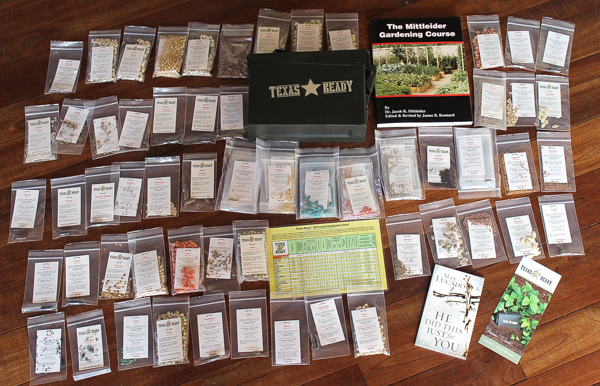
What I Like About The Kit:
This kit is a bit different, in that the makers go out of their way to encourage you to use it rather than just tuck it away in a bunker. They are garden and self-sufficiency evangelists, and they actually want to encourage you to start taking practical steps to improve your own self-sufficiency before you really need it.
From their website: “The bottom line is this. We are selling a lifestyle, not a “survival seed kit” or “emergency seed bank.” We want you to start your garden now so that you can begin learning how to cultivate your plants, harvest your produce and save your seed. This is how you self-sustain, and how you prepare your family for whatever the future may hold.”
I love this. It greatly increases my trust in their company, and I appreciate their honest approach.
They’re also very realistic about long-term seed viability, and they don’t lie to you about how long your seeds are likely to last. Seeds are for growing, not for hoarding.
The kit contains more than 80 varieties of produce but focuses primarily on high-calorie survival foods. There are 5 varieties of corn, including both fresh eating and drying varieties. This kit is the only one to include drying beans (pintos) rather than just fresh green beans.
They’ve included enough types of produce to ensure good variety, but they’ve eliminated some of the more fringe crops like kohlrabi that just confuse many gardeners. As an avid gardener, I can see that the crops they chose to include were selected specifically for high yields, calorie content and good storage life.
Most people don’t choose to grow pinto beans in their day-to-day garden, and wouldn’t have the seeds on hand. If you’re hoping to supplement your food supply in a serious way and be able to store them for winter eating, dry beans are essential.
High in protein and calories, you’ll be glad you have those seeds tucked away. Or, more importantly, that you’ve practiced growing and harvesting them before you really needed it.
I love that they really thought through creating kits for different growing zones. Texas and Vermont are very different growing environments, but they picked excellent varieties for my northern region.
Kurt and Lucinda at Texas Ready want to differentiate their kit from the others on the market by including a growing system along with the seeds. They include gardening books in their kits, and each seed packet has a notecard that tells you where the growing information for that variety can be found in a gardening book.
Everything comes packaged neatly, with smaller seeds packaged inside pill jell caps to prevent spilling. If you’ve ever tried to get small herb seeds out of a static-filled ziploc bag you’ll appreciate this attention to detail. Everything is resealable, which encourages you to USE your kit rather than keeping it sealed up on a shelf as a “just in case.”
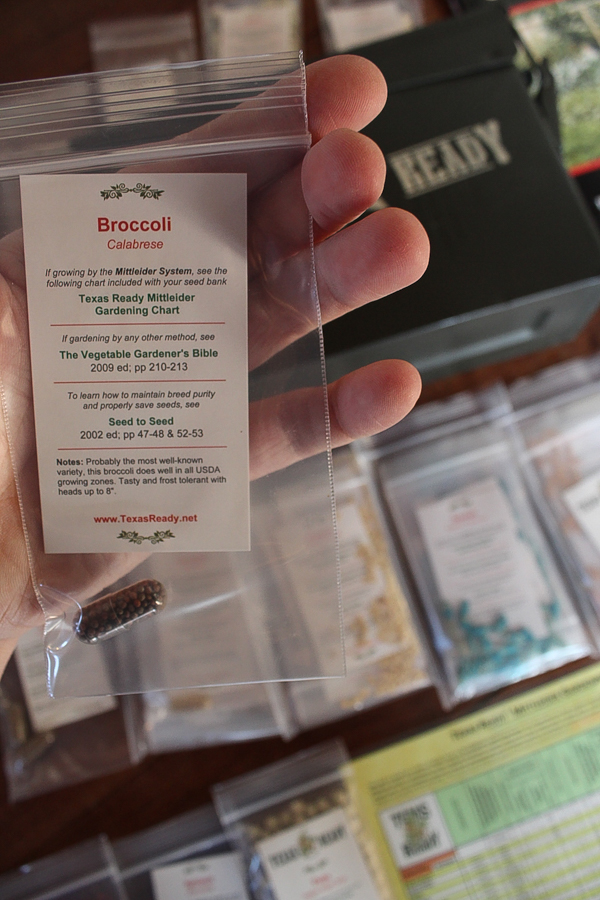
What I Don’t Like:
My only criticism is some of the seed is treated. If you’re a strict organic gardener, some of the seed varieties come pre-coated to improve germination rates and prevent fungal infection. There’s good reason to do this, especially if you’re an inexperienced gardener just getting started that actually wants to see good harvests.
They have very good reasons for treating some susceptible varieties, and here’s what they have to say on their FAQ page:
“Most are not treated, as there is no real need to do so. But certain varieties are very susceptible to fungal infections, infestations, and viruses. Some of these have been treated to enable you to get the hardiest plants and the most bountiful harvest possible. Treated seeds might include certain varieties of corn, squash, peas and/or beans.
There are many different reasons for growing organically, and one of the biggest is the fact that in a survival situation, you aren’t going to be able to run to the gardening center for supplies. We all need to learn how to be as productive as possible with the resources we have on hand if and when the modern conveniences we’ve become accustomed to are no longer available.
That having been said, our intent at TEXAS READY is to prepare people for difficult times which we believe may be coming. In other words, we would not be properly serving our customers by handicapping them in an area where we could otherwise give them a boost. We would rather you harvest 5 lbs of beans grown from treated seeds rather than only 1 lb from seeds that had never been treated – particularly in a crisis situation.”
Who Is The Kit For?
Just about anyone that wants a kit put together by someone you’d want at your back in a disaster. This kit is the best choice for someone at the fringes of a climate zone. If you’re in cold zone 3 or warm zones 9 or 10, this kit has really thought about your needs in ways other kits haven’t.
This kit also enables you to produce, and more importantly, store more calories than any of the other kits. If you’re really hoping to supplement your food supply and grow a substantial amount of your own calories, this is a great choice.
Other Survival Seed Kits
Beyond the three kits I actually tested myself, there are a number of other options available. A few notable ones include:
- Patriot Seeds Organic Seed Vault ~ This is the only survival seed bank I’ve seen to date that includes all organic seed. The crops are mostly low-calorie fresh eating varieties, designed to supplement emergency rations rather than be the sole source of calories.
- Seed Vault Co. Survival Seed Pack ~ The simplest kit I’ve seen, this kit only includes a few varieties, but with very high caloric density. Corn, beans, collards, and squash are all you’ll find, but a lot of each. It’s a big old bucket of seed with over 10 pounds included, supposedly enough to grow food to provide 3000 calories per day for one person. It’s designed for the south and areas with longer growing seasons, so not a practical option up here in the North.
- Valley Food Storage Heirloom Seed Kit ~ Another kit with a relatively small number of varieties, meant to supplement your existing food stores. I mention this kit specifically because Valley Food Storage has the best-tasting freeze-dried survival food kits I’ve ever sampled, and I did an exhaustive review of dozens of different emergency food kits. If you’re already ordering one of their food kits, adding on a small pack of survival seeds for some fresh produce is a great idea.
Any I’ve missed? Have you purchased a survival seed kit, and are you growing out the seed? Leave me a note in the comments with your experiences.
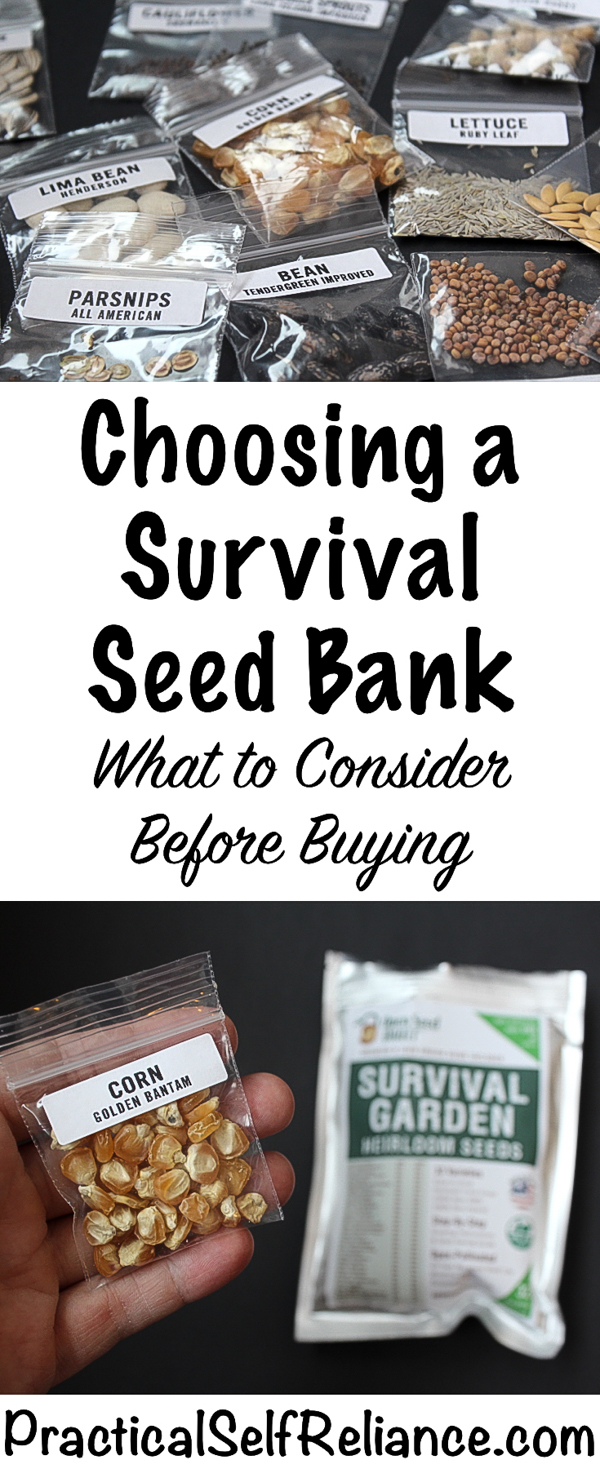
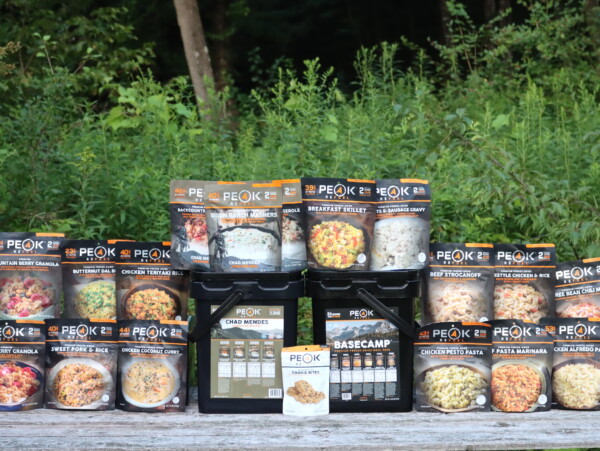
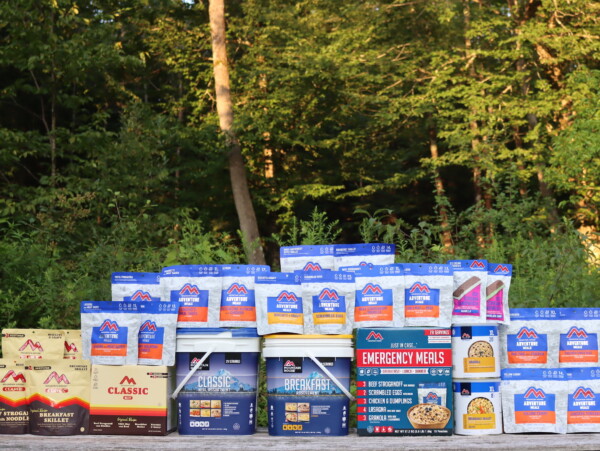
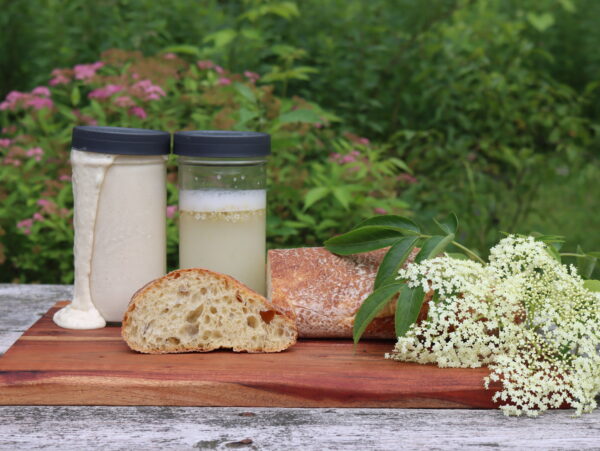
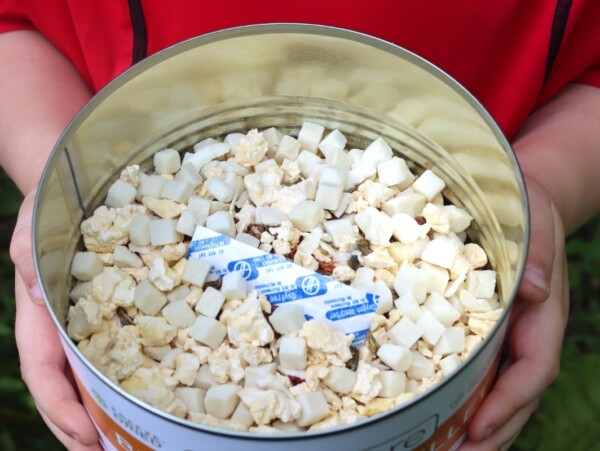










I have been saving seeds for 50 plus years, keeping them sealed, cold and dark in my root cellar. I replace with newly saved seeds yearly but also keep the old seeds to fall back on in case I have to start over genetically. On average they last two to three times longer for me then advertised seed viability for varietyI also did the no no of saving seeds from hybrid peppers and tomatoes and it went really well. I had to fall back on some old tomato seeds because of a fungus and they sprouted after 22 years and only one was genetically damaged..
That’s incredible. Thanks for sharing.
Hi! Do you have any updates after growing the seeds? In particular, how did the Texas Ready brand perform vs Survival Essentials? I see you said in the post you were going to plant in summer of 2018! Thank you for any thoughts!
What do you think of these two sites
https://www.survivalseedbank.com/
https://www.rareseeds.com/
Lets just say im lucky to have family and friends in government and security and they are all telling me to get my house in order. Ultimately seeds may not matter for what may be coming but I will listen to their advice and plan for the worst and pray for the best. Its later than you think.
Survival seed bank is new and I don’t know anything about them. Rare seeds has been around a long time, and I’ve ordered from them several times. They have really unique varieties, but the downside is they don’t give a lot of information about their growing needs. Some are super long season (which wont work here in the north) and others need specific requirements that they don’t spell out when you’re ordering (you’ll have to look it up elsewhere). Their seed packets are also really incredibly small. I do love the variety they offer, and I go to them for specialty stuff you just can’t get anywhere else.
If it came down to it, the wheat seeds are not pointless. Yes, you wouldn’t be able to use them the first time around but in the event that you need long term survival, you would plant the wheat then harvest the seeds from that crop. Obviously this would yield you a bigger future crop. One thing people just starting out tend to forget is learning how to harvest, not just the fruits of their labor but also the seeds for future crops.
NONE of these is suitable for survival situations! They can be a bargain for seeds for next year. But the seeds are NOT suitable to depend on for survival. I bought several different packages and checked them. Lots and lots and lots of lettuce and radish seeds —- not survival foods! As few as 25 bean seeds (green beans, not beans to dry), few corn seeds. Cheap seeds. Buy your own and keep a garden going, saving seeds each year. Or buy a freeze dryer and preserve your own seeds and foods your family can and will eat. In a survival situation, you cannot survive on 2,000. Calories. You will need 4,000.
Hi there, did you ever test the germination of the three seed vaults? How did they do? Thanks 🙂
Yes, I did in fact. I was really impressed with the germination rates in all the kits. All of them averaged way above my expectations, and honestly, I was shocked at how well the seeds from the cheap-o $13 seed kit did, almost every single seed germinated.
Wow that’s very surprising! I was looking at that one on Amazon, but got scared with a couple of the one star reviews that said hardly ANY of them germinated. That would sure be a bummer! Do you have a good book or resource that teaches how to save seeds from your crops for the following year? Thanks
Yeah, I know. I was particularly impressed by the cheap one, and I was expecting horrible germination rates.
So I have three different seed saving books actually.
Most people recommend Seed to Seed, but it’s not my favorite. It has listings for a lot of varieties, but most the entries are cut and pasted from the previous ones and there are quite a few errors (not to mention the same exact text 100 times).
I love The Seed Garden. Really comprehensive and accurate so far as I’ve found thus far, plus not cut and pasted.
I also have The Organic Seed Grower, but that’s directed at encouraging people to become small scale organic seed companies. It talks a lot about mechanical threshers, etc. It does have a lot of great information about the specific challenges of raising seed with organic methods though. For example, without pesticides, there are a lot more pollinating insects, so isolation distances are longer to keep a crop from cross-breeding (for some varieties anyway).
Do you have any recommendations on cultivating a survival garden with seed saving and storage knowledge. I’m a registered nurse who grew up on a ranch in Nevada with one of my jobs was the family garden on over a quarter acre so I have experience growing but I need information on the best survival garden to grow.
I am looking into being self-sufficient and off the grid within the grid if that makes sense as I think we don’t have much time left to prepare ourselves, maybe 2-3 years according to scientific research and my intuition.
Starting a garden this spring and would Love any recommendations on medicinal herbs and plants to grow as medicine
Great questions, and really a complicated subject. We did a survival gardening project this year, where we took time off work and gave ourselves a week to clear as much woodlot as we could, and get it planted with the highest calorie crops we could. (It was going to be garden anyway, and we needed the firewood, so why not do a fun project in the process?). Even with that knowledge, the answer is…it’s tricky. It depends on so much.
If you’re really into this, I’d highly recommend reading “Gardening When it Counts” by Steve Solomon. It’s the best resource I’ve found on the topic. Not really written from a preparedness or end of the world standpoint, more written from a personal economic crisis standpoint where the author needed to grow his food because he was penniless, but still amounts to the same thing in many ways.
For a herb garden, my top picks that I use all the time are:
-Echinacea (for echinacea tea and echinacea tincture)
-Elderberry (for elderberry syrup, oxymel, and gummy bears for the kids)
–Yarrow (for colds and flus as a tea, and topically for bleeding as a tincture)
-thyme (nothing more effective for congestion in my experience)
–elecampane (for coughs)
–bee balm (all manner of uses)
-Comfrey (for pain relieving comfrey salve)
That’s what I’ve got off the top of my head, but I should really think about it and write something on a preparedness herb garden…
Have you heard of or looked into Sustainable seed company? Any thoughts on them?
I hadn’t heard of them, but I just looked them up. They advertise a kit with 22k seeds for about $35, which seems good at first glance. Looking at the seed list though, more than half of the seeds included are lettuce and kale. Literally 14k seeds…all in salad greens. They have just one variety of corn, with around 70 seeds which is barely enough for pollination if they all grow. The squash they include is predominantly summer squash (low calorie and won’t store). No high-calorie crops, and no dry beans of any kind. I just notice though, they have over 1000 mustard green seeds in there…
I assume they found some kind of a great deal on salad green seeds because there’s no real reason to pack it that full of lettuce besides cutting corners.
Happy day.
I’ve just discovered your blog, just in the nick of time too.
In a few weeks time my daughter and I will be starting our adventures in off grid living with a community just starting out in the Hawksbury. (Australia new south wales), a pristine out of the way place that I am so excited to start growing on.
Your blog is clean and full of actual good advise and information.
I will go on the hunt in Aus to source my own seed bank. I am an avid grower already but did not know half the information about seeds that I needed to.
Thank you so much for sharing your knowledge with the world.
PS:
Do you think I could purchase the Texas Ready brand and have it shipped here? Most of our crops here in Australia are were imported at one time or another.
Wonderful, I’m glad I could help! I’m not sure about whether or not Texas Ready can ship to Australia, but I’m sure they would if they could. I’ve never talked to anyone so committed to helping others survive and thrive, and I got a huge dose of southern hospitality talking to Kurt at Texas Ready. They’re amazing there. Here’s the contact info: seeds@texasready.net